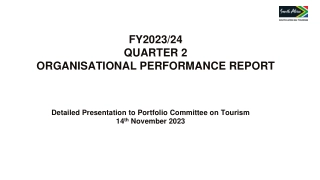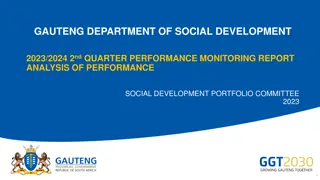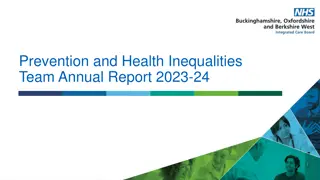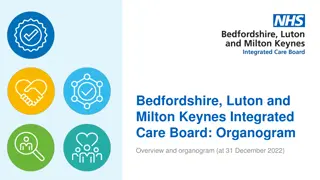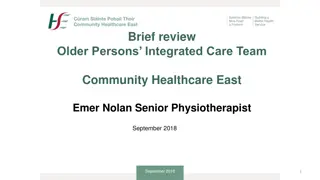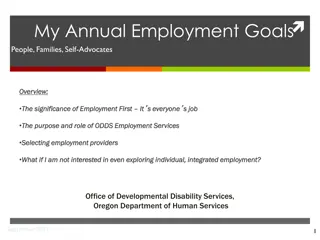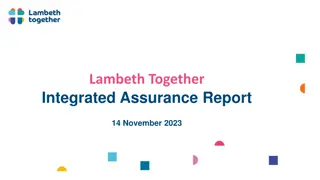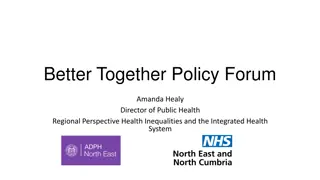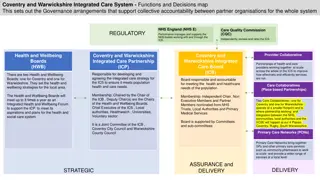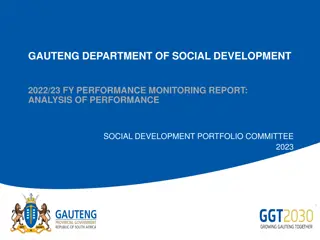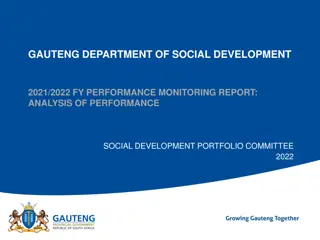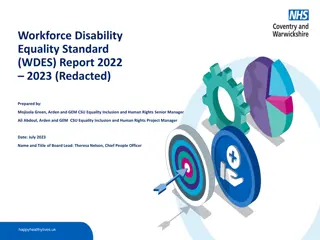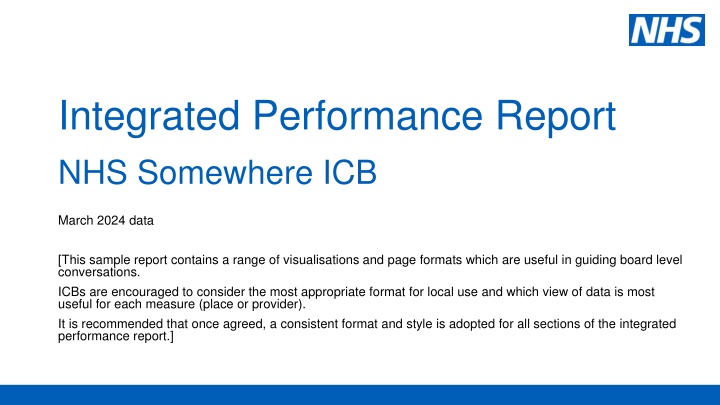
Statistical Process Control (SPC) Charts for Performance Improvement
Learn how to interpret Statistical Process Control (SPC) charts to distinguish between signals and noise in data, identify concerning patterns, and implement improvement actions. Discover the significance of process limits and explore summary icons for at-a-glance insights into performance variation.
Download Presentation

Please find below an Image/Link to download the presentation.
The content on the website is provided AS IS for your information and personal use only. It may not be sold, licensed, or shared on other websites without obtaining consent from the author. If you encounter any issues during the download, it is possible that the publisher has removed the file from their server.
You are allowed to download the files provided on this website for personal or commercial use, subject to the condition that they are used lawfully. All files are the property of their respective owners.
The content on the website is provided AS IS for your information and personal use only. It may not be sold, licensed, or shared on other websites without obtaining consent from the author.
E N D
Presentation Transcript
Integrated Performance Report NHS Somewhere ICB March 2024 data [This sample report contains a range of visualisations and page formats which are useful in guiding board level conversations. ICBs are encouraged to consider the most appropriate format for local use and which view of data is most useful for each measure (place or provider). It is recommended that once agreed, a consistent format and style is adopted for all sections of the integrated performance report.]
Interpreting SPC charts A statistical process control (SPC) chart is a useful tool to help distinguish between signals (which should be reacted to) and noise (which should not as it is occurring randomly). The following colour convention identifies important patterns evident within the SPC charts in this report. Orange there is a concerning pattern of data which needs to be investigated and improvement actions implemented Blue there is a pattern of improvement which should be learnt from Grey the pattern of variation is to be expected. The key question to be asked is whether the level of variation is acceptable The dotted lines on SPC charts (upper and lower process limits) describe the range of variation that can be expected. Concerning variation Expected variation Process limits are very helpful in understanding whether a target or standard (the red line) can be achieved always, never (as in this example) or sometimes. UPL Average LPL Improving variation SPC charts therefore describe not only the type of variation in data, but also provide an indication of the likelihood of achieving target. Target To be less than Summary icons have been developed to provide an at-a-glance view. These are described on the following page. Integrated Performance Report - NHS Somewhere ICB 2
Interpreting summary icons These icons provide a summary view of the important messages from SPC charts Variation / performance icons Icon Technical description What does this mean? What should we do? This system or process is currently not changing significantly. It shows the level of natural variation you can expect from the process or system itself. Consider if the level/range of variation is acceptable. If the process limits are far apart you may want to change something to reduce the variation in performance. Common cause variation, NO SIGNIFICANT CHANGE. Investigate to find out what is happening or has happened. Is it a one off event that you can explain? Or do you need to change something? Special cause variation of a CONCERNING nature. Something s going on! Something, a one-off or a continued trend or shift of numbers in the wrong direction Find out what is happening or has happened. Celebrate the improvement or success. Is there learning that can be shared to other areas? Special cause variation of an IMPROVING nature. Something good is happening! Something, a one-off or a continued trend or shift of numbers in the right direction. Well done! Assurance icons Icon Technical description What does this mean? What should we do? The process limits on SPC charts indicate the normal range of numbers you can expect of your system or process. If a target lies within those limits then we know that the target may or may not be achieved. The closer the target line lies to the mean line the more likely it is the target will be achieved or missed at random. This process will not consistently HIT OR MISS the target as the target lies between the process limits. Consider whether this is acceptable and, if not, you will need to change something in the system or process. You need to change something in the system or process if you want to meet the target. The natural variation in the data is telling you that you will not meet the target unless something changes. This process is not capable and will consistently FAIL to meet the target. If a target lies outside of those limits in the wrong direction then you know the target cannot be achieved. Celebrate the achievement. Understand whether this is by design (!) and consider whether the target is still appropriate; should be stretched, or whether resource can be directed elsewhere without risking the ongoing achievement of this target. This process is capable and will consistently PASS the target if nothing changes. If a target lies outside of those limits in the right direction then you know the target can consistently be achieved. Integrated Performance Report - NHS Somewhere ICB 3
Infographic Integrated Performance Report - NHS Somewhere ICB 4
Overview matrix Integrated Performance Report - NHS Somewhere ICB 5
Executive summary Areas of concern Areas showing improvement The dementia diagnosis rate continues to deteriorate with most recent performance at 53.2% compared to the target of 66.7%. The target is currently unachievable. There has been a concerning deterioration in both the diagnostics and RTT 18 week waiting list position driven by capacity challenges in 3 provider organisations. 2 hour urgent community response has seen a recent deterioration in performance. Currently, the target of 70% will still be comfortably achieved. Performance this month was 86.1% and mean performance 89.3%. This deterioration is being investigated as a matter of urgency due to the risk of ED 4 hour performance being further challenged. The following targets continue to be unachievable with performance remaining unchanged: Prevention and health inequalities for CVD and hypertension have improved, with CVD now consistently able to achieve the target. Learning disability and autism health checks has also shown improvement with performance this month at 10% against the target of 6%. Mean performance is 7%. Improvement continues in the following areas, however the position remains that none of these targets can be achieved without further improvement occurring: RTT 18 week 65+ week waits Diagnostics within 6 weeks Cancer 62 day waits Workforce turnover rate ED 4 hour performance Learning disability and adult inpatient per million Mental health inappropriate out of area placements Integrated Performance Report - NHS Somewhere ICB 6
Mental health: performance summary Mental Health / Learning Disability & Autism Summary Icon Table Assurance Variation Plan Met Lower process limit Upper process limit Latest month KPI Measure Target Mean LD&A Health Checks in Month Mar 24 10% 6% 7% 3% 10% LD&A Adult IP Per Million Mar 24 48.04 30.00 42.25 31.81 52.69 LD&A CYP IP Per Million Mar 24 21.91 12.00 23.59 15.62 31.56 MH Access to Talking Therapies Mar 24 3929 3200 3788 3338 4239 MH Women Access Perinatal CMHS Mar 24 1673 1400 1424 656 2192 MH Severe Illness Access to CMHS Mar 24 17186 21000 20576 13665 27487 MH Access to CYP Services Mar 24 18147 24000 17993 13404 22582 MH Dementia Diagnosis Rate Mar 24 53% 67% 57% 48% 65% MH Inappropriate OOA Mar 24 1257 295 955 574 1335 Integrated Performance Report - NHS Somewhere ICB 7
Key indicator: Dementia Diagnosis Rate Dementia Escalation Points ICB performance is53.2%, which is below the target of 66.7%. Performance since September has shown 7 months of statistically significant deterioration. Only Place C met the local target in March (69.4%), however this target cannot be achieved consistently. Performance is deteriorating in Places A, B and D (actual performance figures appear in the table to the left). Place E is showing statistical improvement with performance at 65.6% in March. The ICB will not meet the 66.7% national ambition this year. The plan that has been submitted is an improving position to 57%. Primary Care Coding and backlog in Memory Assessment Services have been attributed to a reduced rate of performance. Key actions Work has commenced to complete a focused programme to cleanse GP registers and develop a toolkit to improve coding. We know that issues with coding are contributing to the current performance being reported in some of our local places. Efforts will focus primarily in Places A and B initially given their particularly low levels of performance. We have assessed service specifications for memory assessment services and are developing recommendations to address variation within these pathways. The ICB is a partner ICB for the national blood biomarker scheme and is helping to lead work at a regional level on the introduction of disease modifying drugs. We are supporting the implementation of new neuroimaging guidance across NHS Somewhere. Memory Assessment Services update logs to be reviewed 6 weekly in line with dementia steering group to track demand vs capacity. Where contract reports are available these will be reviewed as an alternative. MH Dementia Diagnosis Rate Summary Icon Table Assurance Variation Plan Met Lower process limit Upper process limit Latest month KPI Measure Target Mean ICB Mar 24 53.2% 66.7% 56.8% 48.2% 65.5% Place A Mar 24 49.5% 66.7% 53.4% 45.3% 61.6% Place B Mar 24 46.2% 66.7% 49.8% 38.9% 60.7% Place C Mar 24 69.4% 66.7% 59.5% 47.4% 71.5% Place D Mar 24 58.3% 66.7% 58.7% 53.5% 63.9% Place E Mar 24 65.6% 66.7% 63.4% 52.0% 74.7% How indicator links to long term priorities: Improving Dementia Diagnosis Rate directly supports the ICB long term ambition of transforming people s health and care experiences and outcomes. Earlier diagnosis of often vulnerable patients empowers them and their families and carers to take control of their situation, leading to better management of the disease, better time to plan and therefore an enhanced quality of life. Integrated Performance Report - NHS Somewhere ICB 8
Key indicator: Inappropriate OOA placements Out of Area (OOA) escalation points Performance in March was 1,257 bed days against a plan of 295. Currently there is no significant change in the data and the target of 295 is unachievable. There is some variation in performance with Place E showing a statistical improvement and the lowest number of bed days (10). Place A is also showing improvement however the volume of bed days is much higher at 252. The worsening position at Place B is being investigated urgently. Key actions The Inpatient Quality Transformation draft plan has been submitted to NHS England and has received extremely positive initial feedback. OOA placements is a key workstream within this plan. An ICB workshop for inpatients quality transformation took place in mid-March, with regional and national colleagues attending, as well as people with lived experience of inpatient services. The final plan will be submitted at the end of June 2024. MH Inappropriate OOA Bed Days Summary Icon Table The OOA programme sits as a key element of the overall Mental Health, Learning Disability and Autism (MHLDA) Inpatient Quality and Safety Transformation Programme. Assurance Variation Plan Met Lower process limit Upper process limit Latest month KPI Measure Target Mean In 2024/25 we will focus on: ICB Mar 24 1257 295 955 574 1335 market development with the independent sector to maximise provision within the area, negotiate fair and consistent pricing and enable greater oversight of patients Place A Mar 24 252 90 305 145 464 Place B Mar 24 247 55 240 118 361 Place C Mar 24 49 10 39 3 75 a full review for each major bed type with the relevant stakeholders, including service users and clinical leaders to develop the vision and implementation plans to conduct real change, starting with rehabilitation Place D Mar 24 690 120 554 213 894 Place E Mar 24 19 20 78 12 144 How indicator links to long term priorities: Reducing inappropriate out of area placements directly supports the ICB s long term ambition of transforming people s health and care experiences and outcomes. Transporting often vulnerable patients long distances out of area can be a poor experience for them and demonstrates a lack of local capacity and available services. It has also been identified as one of the ten key priorities due to financial impact of having to fund inpatient stays over and above existing contracted provision. review of housing options to support plans it is clear that development and diversity of community provision will be a key enabler to delivering support closer to home for our populations Integrated Performance Report - NHS Somewhere ICB 9
Inequality overview Age standardised activity rates with 95% confidence intervals for emergency attendances by IMD quintile 52+ week waiting list by deprivation 0% 10% 20% 30% 40% 50% 200 IMD quintile 5 (20% least deprived) 11% 142 150 IMD quintile 4 20% 85 79 IMD quintile 3 34% 100 65 50 IMD quintile 2 19% 50 IMD quintile 1 (20% most deprived) 16% 0 0% 10% 20% 30% 40% 50% IMD quintile 1 (20% most deprived) IMD quintile 2 IMD quintile 3 IMD quintile 4 IMD quintile 5 (20% least deprived) Population Actual 52+ week waiting list by ethnicity Age standardised activity rates with 95% confidence intervals for emergency attendances by ethnicity group 0% 10% 20% 30% 40% 50% 350 290 300 Other 20% 250 White 42% Mixed 200 24% Black 7% 150 Asian 7% 100 65 35 50 14 0% 10% 20% 30% 40% 50% 11 0 Population Actual Asian Black Mixed White Other NHS England s statement sets out the information on health inequalities that, in NHS England s view, relevant NHS bodies should collect, analyse and publish as part of addressing health inequalities. ICB boards should publish a range of health inequality indicators (Core20PLUS5) including measures broken down by deprivation and ethnicity (where available). As examples, the charts above show the number of 52+ week waiters and age standardised rates for emergency admissions broken down by deprivation level and ethnicity. Integrated Performance Report - NHS Somewhere ICB 10
Metric glossary and definitions Improvement Direction Metric Definition Methodology / Exclusions Data Source Up UEC ED 4hr performance Down UEC ambulance CAT2 mean Down RTT 18 wk waiting list Down RTT 18 wk 65+wk waits Down Diagnostics Waiting List Up Diagnostics within 6 wks Down Cancer 28 Day FDS Down Cancer 62 Day Waits Up GP Appointments Up GP Booked & Seen in 14 days Down Community Waiting List Up Community 2hr UCR Up PHI Hypertension Performance Up PHI CVD Performance Up LD&A Health Checks in Month Down LD&A Adult IP Per Million Up MH Dementia Diagnosis Rate Down MH Inappropriate OOA Down Workforce Sickness Rate Down Workforce Turnover Rate Integrated Performance Report - NHS Somewhere ICB 11

